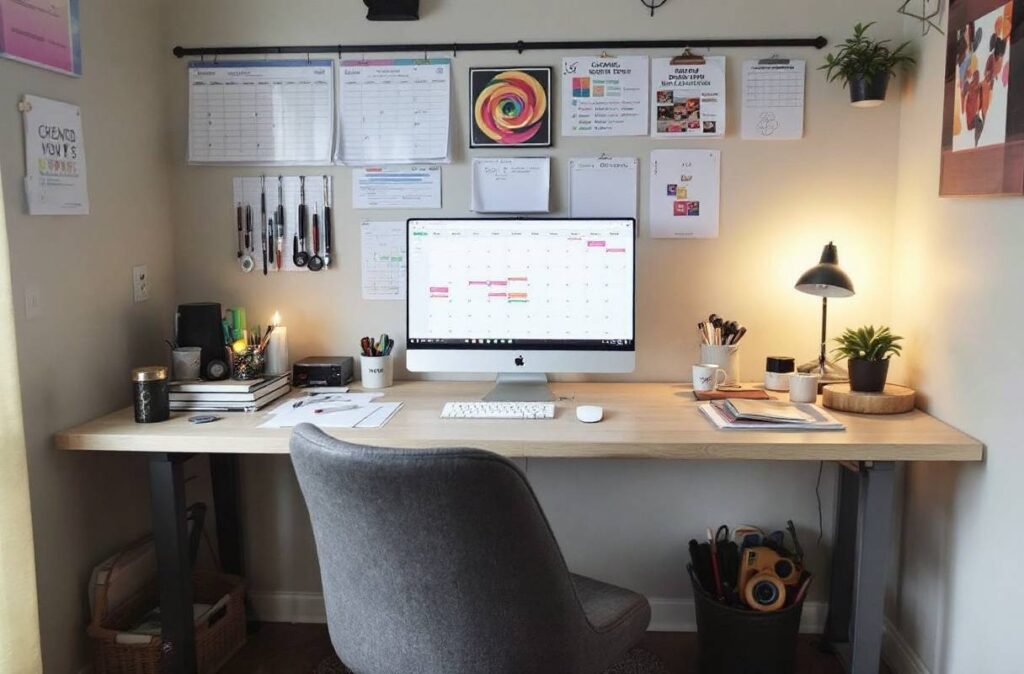Imagine waking up each morning with the flexibility to design your workday around your life, not the other way around.
In today’s dynamic work environment, flexible work arrangements are transforming how we balance productivity and personal happiness.
Whether you’re a remote worker, a parent juggling schedules, or an employer seeking a motivated team, embracing flexible work setups can be the key to unlocking a more fulfilling and efficient work-life harmony.
Embracing Work Flexibility

These days, flexible work setups are the new norm. They’re not just some fancy perk anymore but a crucial part of the way we all work. Getting why they’re needed can help both workers and bosses create workspaces that are chill and productive.
Why Work-Life Balance Matters
Balancing work with life? It’s like the secret sauce for being happy and getting stuff done. When people can juggle work tasks with personal stuff like family or hobbies, stress takes a back seat. Less stress means better mental health and more satisfaction in the job. And hey, when folks are happy, they work harder and better.
Here’s what you get with good work-life jive:
- Stress Busting: Less job stress means better health, both in the mind and body.
- Job Joy: Content workers stick around and throw themselves into what they do.
- Boosted Output: When work doesn’t overload them, folks work smarter and crank out higher-quality stuff.
Curious about how balance can up your game? Swing by our piece on work-life balance benefits.
Different Flexible Work Styles
Flexible work isn’t one-size-fits-all. There’s a mix of styles to suit different folks. Knowing what’s out there helps everyone involved make smarter choices.
Remote Work
Think of remote work as ditching the commute. It allows employees to get stuff done from home, a coffee shop, or anywhere with Wi-Fi. This setup cuts back on commuting hassle, giving more room for life beyond the desk.
Flextime
Flextime lets workers clock in at the hours that make sense to them. It’s perfect for parents, students, or anyone with a life that won’t fit the 9-to-5 mold. It keeps personal commitments from crashing into work duties.
| Flexible Style | What’s It Like? |
|---|---|
| Remote Work | Work from anywhere that’s not the usual office |
| Flextime | Pick your hours within a range that works |
| Compressed Week | Full hours, fewer days |
Compressed Workweek
This one squeezes full-time hours into fewer days. Imagine four days with 10-hour shifts instead of five 8-hour ones. You get longer weekends to recharge, play, or just chill.
Job Sharing
Here, two or more people split one full-time role. It allows part-time hours with zero stress about leaving the job market behind.
Telecommuting
Kind of like the cousin of remote work, telecommuting mixes home days with office visits for tasks or gatherings. A little in person, a little online – the best of both worlds.
These flexible styles serve up a variety of options so folks can keep that work-life balance tight while still getting the job done. For tips on drawing work-life lines, check out our article on setting work boundaries.
Going flexible isn’t just good for employees – it’s a win-win for businesses too. Happier workers mean a more upbeat and efficient workplace.
Benefits of Flexible Work
Flexible work setups come with loads of perks—think amped-up productivity, happier employees, and a smoother blend of work and play.
Enhanced Productivity
Being flexible with work hours can really crank up efficiency. Imagine working when you naturally hit your stride, rather than clocking in on auto-pilot from 9 to 5. This freedom means less frying your brain, more focus, and getting stuff done faster.
By the Numbers: Productivity Boost
| Work Style | Average Jump in Productivity (%) |
|---|---|
| Working Remotely | 20 |
| Flexible Timing | 15 |
| Shorter Work Weeks | 10 |
Want to make the most of your tick-tock? Check out our time management tips for more insight.
Improved Job Satisfaction
Having a say in how you work can make a gig a lot more enjoyable. Giving people the reins on their schedules ups their mood, slashes stress, and builds workplace loyalty. Plus, less job-hopping equals a happier team spirit.
By the Numbers: Job Happiness
| Flexibility Type | Boost in Job Happiness (%) |
|---|---|
| Home Base Ops | 25 |
| Flexi Hours | 20 |
| Part-Time Flex | 18 |
Need tips on keeping work from taking over? Peek at our guide on setting boundaries.
Better Work-Life Integration
Juggling work and personal life is key to keeping spirits high. Flexibility lets employees handle family stuff, dive into hobbies, or just breathe a little without their job dragging them down.
By the Numbers: Parent-Friendly Balance
| Flex Option | Parent Life Balance (%) |
|---|---|
| Work from Home | 30 |
| Job Split | 25 |
| Flexi Schedule | 22 |
Get the lowdown on balancing work with parenthood in our article on work-life harmony for parents. Trying out mindfulness at work can also help keep everything in check.
Bosses and HR folks, take note! These benefits make a strong case for giving flexible work setups a go—leading to a more motivated and productive crew.
Challenges and Solutions
Trying to master the flex work game? It’s got its quirks. Knowing the bumps along the way and coming up with smart fixes can keep both workers and bosses in their happy zones.
Overcoming Remote Work Challenges
Sure, remote work sounds dreamy, but it’s got its hiccups, mostly around keeping work life from spilling into personal life and keeping the lines of chat clear.
Isolation and Communication
Feeling like you’re on a deserted island while remote working? It’s real. Keeping a vibe going with the team is key.
Solutions:
- Regular Check-ins: Make video meeting catch-ups a regular thing—daily or weekly. Keeps the gang tight.
- Virtual Social Activities: Get creative with online coffee chats or fun activities to keep everyone in the loop and happy.
| Challenge | Solution |
|---|---|
| Isolation | Regular Check-ins, Virtual Social Activities |
| Can’t Communicate | Use Collaborating Tools, Clear Channels |
Blurred Work-Life Boundaries
Home or office? Sometimes it’s tough to tell. Remote workers need to draw the line.
Solutions:
- Designated Workspace: Find a corner at home that’s strictly for working.
- Set Work Hours: Clock in and out at set times. Balance is everything.
For more tips, check out our piece on setting work boundaries.
| Challenge | Solution |
|---|---|
| Mixing Business with Pleasure | Designated Workspace, Set Work Hours |
| Too Loud to Work | Ergonomic Home Setup, Set Family Rules |
Addressing Time Management Issues
In the flex work zone, time can slip through your fingers without office walls to guide you. A little pencil-pushing discipline goes a long way.
Procrastination and Overworking
Getting the job done without overdoing it—that’s the catch. Procrastination and overdoing can throw you off.
Solutions:
- Task Scheduling: Grab a planner or open an app to jot down tasks and their time slots. Peek into our best time management apps.
- Pomodoro Technique: Try working in bursts—25 minutes work, 5 minutes break. It’s a focus hack.
| Challenge | Solution |
|---|---|
| Stalling the Day Away | Task Scheduling, Pomodoro Technique |
| Burning the Midnight Oil | Scheduled Breaks, Take a Tech Time-out |
Prioritizing Tasks
Without a to-do list that makes sense, you might end up juggling too many balls.
Solutions:
- Eisenhower Matrix: Sort your tasks by what’s super urgent versus what’s important.
- Effective Delegation: Let someone else carry part of the load. Learn how with effective delegation techniques.
| Challenge | Solution |
|---|---|
| Task Tangle | Eisenhower Matrix, Effective Delegation |
By meeting these hiccups head-on with clever answers, both lone rangers and whole teams can really soak in the perks of flex working. Dive into more tips with our guides on work-life integration for parents and keeping burnout at bay.
Strategies for Success

Setting Boundaries
Keeping work and home life separate can be a game-changer, especially when you’re working from home. Crafting that invisible line between your job and personal time can help dodge burnout and boost your mojo.
Tips for Setting Boundaries:
- Define Work Hours: Pick your work hours and stick to them like glue. Let your colleagues know when you’re on and off the clock. Use your calendar as your trusty aide.
- Designate a Workspace: Set up shop in a spot that’s not your living room couch. Creating a little nook for work can signal to your brain when it’s time to hustle and when to chill.
- Chat with Housemates: Make sure your family or roomies know your work vibes. They should respect your office hours and your mini-home-office.
Want more boundary ideas? Visit our piece on setting work boundaries.
Establishing Clear Communication Channels
Chit-chat is king, especially when you’re working away from the office. Staying in the loop with your colleagues can squash mix-ups and nurture teamwork.
Strategies for Clear Communication:
- Regular Check-Ins: Set a rhythm with regular meet-ups to touch base on projects and squash problems. Video, phone, or even app messages – your choice.
- Use Project Management Tools: Turn to tools like Trello, Asana, or Slack to keep track of who’s doing what and when it’s due.
- Set Expectations: Lay out who does what, and when it needs to be done by. Make sure everyone is on the same page.
For a deeper dive into boosting your communication, check out our post on mindfulness at work.
Utilizing Technology Effectively
Tech is your sidekick when working flexibly. Picking the right gadgets and gizmos helps keep things moving smoothly and keeps everyone in the loop.
Types of Technology for Flexible Work:
- Collaboration Tools: Google Workspace and Microsoft Teams are your buddies for sharing and working together on docs.
- Time Management Apps: Try out apps like Toggl or Clockify to keep an eye on your work hours and stay on schedule. Peep our guide on best time management apps.
- Communication Platforms: When it’s time for face-to-face chats, Zoom or Skype have got your back.
Table: Popular Tools for Flexible Work
| Type | Tool | Purpose |
|---|---|---|
| Collaboration | Google Workspace | Document sharing and real-time teamwork |
| Project Management | Trello | Keeping track of tasks |
| Time Management | Toggl | Watching the clock |
| Communication | Zoom | Video chats |
Need more tech tips? Swing by our article on ergonomic home office setup.
By rolling with these strategies, you’re setting yourself up for a win in the flexible work game, keeping both your productivity and sanity intact.
Implementing Flexibility in the Workplace
Company Culture and Policies
Thinking about a flexible workplace? It all starts with a company culture that genuinely cares about work-life harmony. You gotta have those policies that fit the bill—think working remote, picking your hours, or even job-sharing magic. When employees know their lives outside work matter, you’ll see them spark with energy and dedication. Wanna know how to build that vibe? Check out some tips here.
Besides those flexible gigs, taking off with vacation time, mental health days, or weekly wellness plans can really help folks find a groove between work and personal life.
Check Out These Flexible Work Policies:
| Policy Type | What It Is | Why It Rocks |
|---|---|---|
| Remote Work | Work from home or anywhere but the office | More freedom, bye-bye commute stress |
| Flexible Hours | Start when you want within limits—more chill | Fit work around real life |
| Job Sharing | Two people sharing the full-time load | Keep talent around, find balance easily |
| Compressed Workweeks | Pack hours into fewer days (hello, Friday!) | Longer breaks, work-life made simple |
These tweaks can unleash tons of work-life balance benefits.
Training and Support for Employees
Got those flexible schedules? Then you’ve gotta equip your folks to make it work like a charm. Sneak in some workshops or helpful resources on boss-level time management, setting clear work limits, and staying on top of things when you’re not in the office.
Don’t forget the tech! You’ve gotta roll with innovative tools that get the job done, like apps for teamwork or safe remote logins. It’s smart to keep these updated and solid. Get a few “flexibility champs” who can coach the others on rocking the new work styles.
Ace Employee Support with These Tools:
| Support Type | What’s in Store |
|---|---|
| Time Management Training | Workshops teaching smart time management |
| Boundary Setting Guidance | Help with knowing when to switch off from work |
| Wellness Programs | Ideas to pump up the body and mind |
| Technology Training | Demos on using the latest productivity gear |
Such support vibes not only make flex work a breeze for employees but also amp up their loyalty and job joy. For extra ways to boost your team’s happiness, dive into the secret sauce of workplace wellness programs.
Case Studies
Let’s get into some real-life examples of how companies and folks make flexible work tick. These stories give us a peek at what’s been a hit and where the hiccups happened.
Success Stories of Flexible Work Arrangements
- Some companies and their people have nailed flexible work setups. Check these out:
- Tech Company A: They’re on the “working from home” train, letting their crew clock in from the couch three days a week. The outcome? A sweet 25% jump in job happiness and a neat 15% bump in getting stuff done.
| How It Stands | Before Going Flex | After Going Flex |
|---|---|---|
| Job Happiness (%) | 70 | 95 |
| Productivity Boost (%) | – | 15 |
- Consulting Firm B: Cut back to a four-day work week. Employees are chattier about how work doesn’t eat their whole week, which slashed sick days and fewer folks waved goodbye.
| How It Stands | Before Going Flex | After Going Flex |
|---|---|---|
| Sick Days Every Year | 10 | 5 |
| Employee Turnover (%) | 12 | 5 |
| Lessons Learned | from Different | Work Scenarios |
Lessons Learned from Different Work Scenarios
Eyeballing different setups shows the bits that make or break flexible work.
- Remote Work Whammies: Some peeps were knee-deep with no real divide between work-life and home-life. Companies setting clear “on” and “off” times and dishing out work boundary tips upped job vibes and mojo.
- Clock-Watching Woes: If clock-watching was a sport, some employees were pros. They sharpened their game with time management skills and training drills, which cooled down the stress and sped up the workflow.
- Family-First Ways: Businesses that flipped the script with flexible hours and remote gigs saw clouds of cheer from parents juggling home and office. This was a game-changer for blending work and family hustle.
| Situation | What Worked | The Payoff |
|---|---|---|
| Work-Home Blur | Crystal clear rules | More pep in the step, happy campers |
| Time Juggling | Time tactics and training | Got more done, felt less “AARGH” |
| Parents | Flex hours, remote gigs | Parents rode the happy train |
These tales show why having a way that fits and backing it up is key for maxing out the goodness of flexible setups for both workers and bosses. If you’re on the hunt for tips on keeping that work-life juggle tight, check out our bits on work-life balance boosts and balancing career and home antics.
Tips for Employees
Negotiating Flexible Work Arrangements
Getting that sweet flexible work setup might seem a bit tricky, but it’s key to staying sane while juggling work and life. Here’s how you can nail those negotiations like a pro:
- Know the Rulebook: Before you ask, you gotta know what’s already allowed. Check out what your company’s cool with when it comes to flexible work. It’ll make your case stronger.
- Put Together a Plan: Craft a clear pitch. Explain what kind of flexibility you want, how it helps you and the company, and how you’ll keep the ball rolling work-wise.
- Play Up the Perks: Show them the good stuff—how being flexible boosts your productivity and keeps burnout at bay. Need more reasons? Dive into our piece on work-life balance benefits.
- Spill the Details: Be upfront about what you’re after, like remote work or funky hours. Specifics make it easier for the boss to give a thumbs-up.
- Suggest a Test Drive: Offer a trial run to show ’em it works. It’s a no-risk way for your employer to see things in action.
- Book a Chat: Set up a proper meeting with your manager to talk things over. Be ready to haggle and adjust your plans.
Maintaining Work-Life Balance
Once you’ve unlocked those flexible hours, keeping your work and life in check takes some effort. Here’s the lowdown:
- Draw the Line: Decide your work hours and stick to ’em. Tell your work buddies when you’re around and when you’re not. Peek at our guide on laying down work boundaries for more tricks.
- Carve Out Your Den: Find a spot in your home where work happens. Keep it separate from your chill zone. Check out how to make it comfy and efficient in our ergonomic home office setup article.
- Master Your Time: Keeping your day organized is vital. Use tools and tricks to stay on track. Got your back with our time management techniques article.
- Give Yourself a Breather: Treat breaks like treasure—they keep you sharp. Step away from screens and recharge. Take those lunch breaks somewhere nice away from work gear.
- Zen Out: Mindfulness practices can melt stress. Try meditation or yoga. We’ve got the lowdown on finding peace in mindfulness at work.
- Keep Talking: Chat with coworkers and your boss to keep things clear. Good communication stops hiccups and keeps the place positive.
- Put Yourself First: Do stuff that makes you feel good, like working out, sleeping enough, and munching on healthy bites. Check our healthy habits for professionals for a well-being boost.
With a solid handle on flexible work setups and a focus on keeping life balanced, you can enhance both productivity and happiness. For more tips on living a good life, have a look at our other posts.
Tips for Employers
Creating a Flexible Work Policy
A flexible work setup can make your folks happier and more productive. Giving the team a heap of choices helps balance their work-life juggle with a lot less hassle.
- Check What’s Needed: Figure out what your company and crew actually need. Think about which work setups make sense—be it working from home, unusual hours, or doing more with fewer days on the job.
- Lay Down the Rules: Make it easy to understand who can join these flexible setups and how to sign up. Be super clear about hours, how you’ll keep in touch, and how you’ll know the work’s getting done right.
- Trial Runs: Try small test runs on new work setups before going all in. Get some feedback and tweak things as needed to suit the gang better.
- Stay Legal: Make sure you’re playing by the rules of local work laws. This means checking stuff like overtime, wages, and what rights everyone has.
Supporting Employee Well-Being and Work Flexibility
To really nail down the benefits of flexible work, looking out for your crew’s well-being is a must. Here’s how to give support where it counts:
- Wellness Hits: Start programs that help folks stay fit, relaxed, and mentally chill. A healthy bunch is a happy, hard-working bunch.
- Learn and Grow: Hand out training sessions to help people manage their time better, deal with stress, and make working from anywhere a breeze.
- Stay Connected: Hook everyone up with solid tools for chatting, video calls, and sharing docs, so nobody’s left hanging.
- Check In Often: Have regular chats with folks about their workload, how they’re feeling, and if anything’s getting on their nerves. Show you’ve got their back.
- Keep Work in Its Place: Encourage people to draw lines between work and play to keep burnout at bay. Share tips on making space for work without work taking over.
- High Fives and Shout-Outs: Appreciate and recognize the crew who go above and beyond. A little acknowledgment goes a long way and keeps the vibe positive.
By following these steps, bosses can cook up a workspace where flexibility works for everyone, ramping up happiness, keeping things productive, and helping folks blend work and life like a pro.
| Strategy | What’s it all about |
|---|---|
| Wellness Hits | Get folks into mental health support, fitness routines, and ways to de-stress |
| Learn and Grow | Offer ways for improving time handling, handling stress, and setting up shop at home |
| Stay Connected | Equip teams with tools for video, chat, and sharing stuff, keeping everyone in the loop |
| Check In Often | Set regular catch-ups to chat about work, hurdles, and how folks are doing |
| Keep Work in Its Place | Encourage creating barriers between job time and downtime |
| High Fives and Shout-Outs | Celebrate star players for excellent work and adaptability |
For more ideas on keeping work smooth, check out our pieces on juggling work and life for parents, snuffing out the risk of burnout, and taking mindfulness to the desk.
Conclusion
Embracing flexible work arrangements isn’t just a trend—it’s a transformative strategy that benefits both employees and employers. By offering diverse work styles, fostering job satisfaction, and implementing smart solutions to common challenges, organizations can create a thriving, motivated workforce.
Whether you’re negotiating your own flexible setup or designing policies for your team, prioritizing flexibility leads to enhanced productivity, better work-life balance, and a happier, more engaged workplace. It’s time to redefine the way we work and unlock the full potential of flexible work arrangements.
FAQs
What are the main types of flexible work arrangements?
Flexible work arrangements include remote work, flextime, compressed workweeks, job sharing, and telecommuting, each offering different ways to balance work and personal life.
How does flexible work improve productivity?
Flexible work allows employees to work during their most productive hours, reduces commuting time, and lowers stress, all of which contribute to increased efficiency and higher quality output.
What are the benefits of flexible work for employers?
Employers benefit from higher employee satisfaction, reduced turnover, increased productivity, and a more motivated and engaged workforce.
How can employees maintain work-life balance in a flexible setup?
Employees can maintain balance by setting clear work hours, designating a workspace, mastering time management, taking regular breaks, and practicing mindfulness.
What challenges might arise with flexible work, and how can they be addressed?
Challenges include isolation, communication issues, and blurred work-life boundaries. Solutions involve regular check-ins, virtual social activities, clear communication channels, and designated workspaces.





















